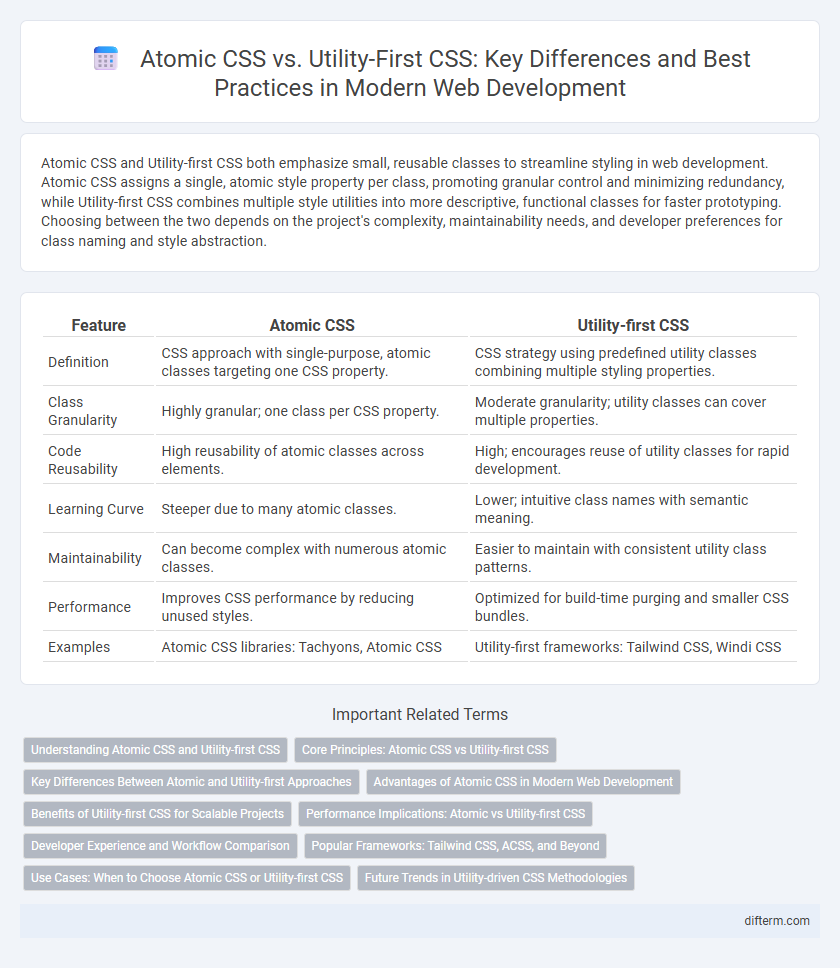Atomic CSS and Utility-first CSS both emphasize small, reusable classes to streamline styling in web development. Atomic CSS assigns a single, atomic style property per class, promoting granular control and minimizing redundancy, while Utility-first CSS combines multiple style utilities into more descriptive, functional classes for faster prototyping. Choosing between the two depends on the project's complexity, maintainability needs, and developer preferences for class naming and style abstraction.
Table of Comparison
| Feature | Atomic CSS | Utility-first CSS |
|---|---|---|
| Definition | CSS approach with single-purpose, atomic classes targeting one CSS property. | CSS strategy using predefined utility classes combining multiple styling properties. |
| Class Granularity | Highly granular; one class per CSS property. | Moderate granularity; utility classes can cover multiple properties. |
| Code Reusability | High reusability of atomic classes across elements. | High; encourages reuse of utility classes for rapid development. |
| Learning Curve | Steeper due to many atomic classes. | Lower; intuitive class names with semantic meaning. |
| Maintainability | Can become complex with numerous atomic classes. | Easier to maintain with consistent utility class patterns. |
| Performance | Improves CSS performance by reducing unused styles. | Optimized for build-time purging and smaller CSS bundles. |
| Examples | Atomic CSS libraries: Tachyons, Atomic CSS | Utility-first frameworks: Tailwind CSS, Windi CSS |
Understanding Atomic CSS and Utility-first CSS
Atomic CSS consists of single-purpose, immutable classes that apply one specific style rule, promoting reusability and reducing stylesheet bloat. Utility-first CSS expands on this by offering a comprehensive set of predefined classes for common CSS properties, enabling rapid UI development with consistent design patterns. Both methodologies emphasize modularity and maintainability, but Utility-first CSS often integrates tooling for customization and responsive design.
Core Principles: Atomic CSS vs Utility-first CSS
Atomic CSS emphasizes creating highly specific, single-purpose classes that apply one style property per class, ensuring minimal redundancy and maximum reusability. Utility-first CSS organizes styles into broader utility classes that combine multiple properties for faster development with consistent design patterns. Both approaches prioritize modularity and maintainability but differ in granularity and class complexity for scalable front-end architecture.
Key Differences Between Atomic and Utility-first Approaches
Atomic CSS assigns a single, specific style per class, promoting precise reuse and minimal style overlap, while Utility-first CSS groups multiple related styles within one class to streamline complex designs. Atomic CSS enhances granular control over each property, enabling meticulous customization, whereas Utility-first CSS accelerates development speed with comprehensive utility classes covering common design patterns. Key differences include Atomic CSS's focus on atomicity and performance optimization versus Utility-first CSS's emphasis on rapid prototyping and design consistency through broader utility combinations.
Advantages of Atomic CSS in Modern Web Development
Atomic CSS offers highly granular control over styling by assigning single-purpose classes, leading to minimal CSS code and faster page load times. It enhances maintainability through reusable, consistent styles that reduce redundancy and prevent style conflicts in large-scale projects. The modular nature of Atomic CSS improves developer productivity by enabling rapid prototyping and easier debugging in modern web development workflows.
Benefits of Utility-first CSS for Scalable Projects
Utility-first CSS enhances scalability in large projects by promoting reusable, single-purpose classes that reduce redundancy and simplify maintenance. Its atomic approach to styling encourages consistent design systems, enabling faster development cycles and easier collaboration among teams. The modular nature of utility-first CSS also improves performance by minimizing unused styles and streamlining CSS delivery.
Performance Implications: Atomic vs Utility-first CSS
Atomic CSS offers highly granular class definitions that can reduce CSS file size by reusing minimal style units across the application, often leading to faster rendering and improved load times. Utility-first CSS, with its slightly broader scoped classes, may result in larger initial CSS payloads but enhances maintainability and scalability, potentially minimizing runtime style recalculations. Performance comparisons depend on project complexity, but Atomic CSS tends to outperform in small-to-medium projects due to smaller CSS bundles, while Utility-first approaches optimize developer productivity and long-term performance optimizations in larger applications.
Developer Experience and Workflow Comparison
Atomic CSS offers highly granular, single-purpose classes that enhance developer experience by enabling precise style control and reducing CSS file size. Utility-first CSS frameworks like Tailwind CSS streamline workflow with predefined, composable classes that accelerate prototyping and improve maintainability through consistent design patterns. Both approaches optimize developer productivity but differ in granularity and abstraction level, impacting code readability and customization flexibility.
Popular Frameworks: Tailwind CSS, ACSS, and Beyond
Tailwind CSS leads the utility-first CSS movement with its highly customizable, atomic-style class naming that enables rapid UI development through composable utility classes. ACSS (Atomic CSS) emphasizes minimal, single-responsibility classes designed to reduce CSS file size and improve maintainability by strictly adhering to atomic principles. Other frameworks like Tachyons and Basscss extend this paradigm by balancing atomic and utility-first approaches, prioritizing performance and scalability in modern frontend development.
Use Cases: When to Choose Atomic CSS or Utility-first CSS
Atomic CSS excels in projects requiring highly granular control over styles with minimal design complexity, making it ideal for small-scale applications or prototypes where rapid styling is essential. Utility-first CSS frameworks like Tailwind CSS are better suited for larger, scalable projects demanding consistent design systems and maintainability, as they provide a comprehensive set of predefined classes enhancing developer productivity. Choosing between Atomic CSS and Utility-first CSS depends on the project's scope, team experience, and the need for design consistency versus rapid, flexible styling.
Future Trends in Utility-driven CSS Methodologies
Utility-first CSS methodologies are evolving to enhance scalability and maintainability in large-scale applications, leveraging atomic CSS principles to minimize redundancy and improve performance. Emerging tools integrate advanced compilation techniques and runtime optimizations, enabling dynamic style generation tailored to component-level needs. Future trends indicate a convergence of utility-driven CSS with design systems, promoting consistency while supporting developer productivity through enhanced customization and theming capabilities.
Atomic CSS vs Utility-first CSS Infographic

 difterm.com
difterm.com